PİŞMANLIK PROGRAMLARI
Kartellerle mücadele, rekabet otoritelerinin en önemli görevlerindenbiridir. Rekabet otoritelerinin kartelleri yıkma çabalarına rağmen, halakarteller kurulmaya ve işlemeye devam etmektedir. Zira, kartellerin gizliyapısı, tespit edilmesi, ispatlanması ve kovuşturması için yeterince delilbulmaya daha fazla yetki gerektirmesi nedeniyle kartellerle mücadele çokzorlu bir görevdir. Bu nedenle pişmanlık programları, kartelleri yıkmaktagittikçe daha önemli hale gelmektedir.Bu makalenin amacı, dünyada pekçok hukuk düzeninde kullanılanpişmanlık programlarını araştırmak ve pişmanlık programları nedengereklidir, nasıl çalışır, önkoşulları nelerdir gibi konuları açıklamaktır.Makale şu bölümlerden oluşmaktadır: 1. bölüm karteller ve kartelpolitikasına ilişkin bir giriş sağlayacaktır. İkinci bölümde pişmanlıkprogramı uygulamanın sebepleri tartışılacaktır. Üçüncü bölümde isepişmanlık programının çalışma mekanizması ele alınacaktır. Dördüncübölümde başarılı bir pişmanlık programının ön koşulları ortaya konacakve beşinci bölümde makale sonuçlandırılacaktır
Anahtar Kelimeler:
Kartel, hard-core kartel, pişmanlık programı, af, aldatma
LENIENCY PROGRAMMES
The fight against cartels is one of the most important tasks of competitionagencies. Although competition agencies CAs continue to increase theirefforts to break down cartels, they have still continued to form andoperate. Because the fight against cartels is a challenging task due totheir secret nature, more powers are required to gather enough evidenceto detect, prove and prosecute infringement. That is why leniencyprograms, which have a complex nature, are clearly becomingincreasingly important to breaking down cartels.The purpose of this article is survey the basis for leniency programswhich have been used in several jurisdictions around the world andexplain why the leniency programs are necessary, how they work, whattheir prerequisites are.The article is structured in the following way: Section 1 provides an
Keywords:
Cartel, hard-core cartel, leniency programmes, amnesty, cheating,
___
- AUBERT, C., REY, P. and KOVACIC, W.E., (2006), “The Impact of Leniency and Whistle-Blowing Programs On Cartels”, International Journal of Industrial Organization, No:24(6), p.1241-1266.
- AZEVEDO, J. P. (2003), “Crime And Punishment In The Fight Against Cartels: The Gathering Storm”, E.C.L.R., 24(8), 400-407.
- BUCCIROSSI, P. and SPAGNOLO, G. (2005), “Optimal Fines in the Era of Whistleblowers. Should Price Fixers Still Go to Prison?”, Lear Research Paper 05-01, http://papers.ssrn.com/sol3/papers.cfm?abstract_id=871726 last visited 01 April 2009.
- BUCCIROSSI, P. and SPAGNOLO, G. (2007), Antitrust Sanction Policy In The Presence Of Leniency Programs, accessible at http://www.gianca.org/PapersHomepage/Buccirossi%20Spagnolo%20
- %20Antitrust%20Sanction.pdf, last visited 01 April 2009.
- CHEN, J. and HARRINGTON, J.E. (2005), The Impact of the Corporate Leniency Program on Cartel Formation and the Cartel Price Path, accesible at http://www.econ.jhu.edu/People/Harrington/leniency4-05.pdf last visited 01 Apr 2009.
- EVENETT, S.J., LEVENSTEIN, M.C. and SUSLOW, V.Y. (2001), “International Cartel Enforcement: Lessons from the 1990s”, The World Economy, No:24 (9), also accessible at http://www3.interscience.wiley.com/journal/118991795/abstract, last visited 01 April 2009.
- FRIEDERISZICK, H.W. and MAIER-RIGAUD, F.P. (2007), “The Role of Economics in Cartel Detection in Europe”, Working Paper No: 014/03/2007, accessible at http://www.esmt.org/fm/312/Role_of_Economics_in_Cartel_Detection_in _Europe.pdf, last visited 01 Apr 2009.
- HAMMOND, S. D. (2000), “Fighting Cartels - Why And How? Lessons Common to Detecting and Deterring Cartel Activity”, Stockholm, Sweden, accesible at http://www.usdoj.gov/atr/public/speeches/6487.htm last visited 01 April 2009.
- HAMMOND, S.D. (2004), “Cornerstones of An Effective Leniency Program”, ICN Workshop on Leniency Programs, accesible at http://www.usdoj.gov/atr/public/speeches/206611.htm last visited 01 April 2009.
- HARRINGTON, J. E (2006)., “Corporate Leniency Programs and the Role of the Antitrust Authority in Detecting Collusion”, International Symposium on Towards an Effective Implementation of New Competition Policy
- http://www.econ.jhu.edu/People/Harrington/Tokyo.pdf, last visited 01 April 2009.
- Tokyo, accesible at HINLOOPEN, J. and SOETEVENT, A.R. (2005), An Experimental Investigation of the Effects of Leniency Programs for Antitrust Enforcement, accessible at http://www.fep.up.pt/conferences/earie2005/cd_rom/Session%20IV/IV.G/ Hinloopen_Soetevent.pdf, last visited 01 April 2009.
- ICN (2005), “Defining Hard Core Cartel Conduct Effective Institutions Effective Penalties: Building Blocks for Effective Anti-Cartel Regimes”, Working
- http://www.internationalcompetitionnetwork.org/media/library/conference _4th_bonn_2005/Effective_Anti-Cartel_Regimes_Building_Blocks.pdf
- last visited 01 April 2009. Cartels, Bonn, Germany, accessible
- at ICN (2006), “Anti-Cartel Enforcement Manual: Enforcement Techniques, Chapter 2: Drafting and Implementing an Effective Leniency Program”, Working Group on Cartels, Capetown, South Africa, accesible at http://www.internationalcompetitionnetwork.org/media/library/conference _5th_capetown_2006/FINALFormattedChapter2-modres.pdf, last visited 01 April 2009.
- LELIEFELD, D. and MOTCHENKOVA, E. (2007), “To Protect In Order To Serve, Adverse Effects Of Leniency Programs In View Of Industry Asymmetry”, TILEC Discussion Paper No:2007-007, accessible at http://papers.ssrn.com/sol3/papers.cfm?abstract_id=963110#PaperDownlo ad, last visited 01 April 2009.
- LESLIE, C.R. (2004), “Trust, Distrust, and Antitrust”, Texas Law Review, No:82(3), accesible at http://www.utexas.edu/law/journals/tlr/abstracts/82/82leslie.pdf, last visited 01 April 2009.
- LEVENSTEIN, M. C. and SUSLOW, V. Y. (2002), “What Determines Cartel Success?”, University of Michigan Business School Working Paper No. 02–001, available at http://www.ssrn.com/abstract=299415, last visited 01 April 2009.
- LEVENSTEIN, M.C. and SUSLOW, V.Y. (2006), “Determinants of International Cartel Duration and the Role of Cartel Organization”, University of Michigan Business School Working Paper No:1052, accessible at http://papers.ssrn.com/sol3/papers.cfm?abstract_id=936912 last visited 01 April 2009.
- MOTTA, M. and POLO, M. (2003), “Leniency Programs and Cartel Prosecution”, International Journal of Industrial Organization, No: 21(3), p.347-379.
- OECD (1998), Recommendation of the Council Concerning Effective Action Against Hard Core Cartels, OECD, Paris, accesible at http://www.oecd.org/dataoecd/39/4/2350130.pdf, last visited 01 April 2009.
- OECD (2001), “Report On Leniency Programmes To Fight Hard Core Cartels”, DAFFE/CLP(2001)13, Paris, France, accesible at http://www.oecd.org/dataoecd/49/16/2474442.pdf, last visited 01 April 2009.
- OECD (2002), Report On The Nature and Impact Of Hard Core Cartels and Sanctions Against Cartels Under National Competition Laws, OECD, Paris, accessible at http://www.oecd.org/dataoecd/16/20/2081831.pdf, last visited 01 April 2009.
- OFFICE OF FAIR TRADE (2005), Predicting cartels, OFT Report OFT773, London, UK, accessible at http://www.oft.gov.uk/shared_oft/reports/comp_policy/oft773.pdf
- visited 01 April 2009.
- last SPAGNOLO, G. (2004), “Divide et Impera: Optimal Leniency Programs”, CEPR Discussion Paper No:4840, accesible at http://papers.ssrn.com/sol3/papers.cfm?abstract_id=716143, last visited 01 April 2009.
- SPAGNOLO, G. (2006), “Leniency and Whistleblowers In Antitrust”, Discussion Paper No. 5794, accessible at http://papers.ssrn.com/sol3/papers.cfm?abstract_id=936400, last visited 01 April 2009.
- STEPHAN, A. (2006), “The Bankruptcy Wildcard in Cartel Cases”, CCP Working Paper 06-5, Norwich, UK, accessible at http://www.ccp.uea.ac.uk/publicfiles/workingpapers/CCP06-5.pdf, last visited 01 April 2009.
- STIGLER, G. (1964), “A Theory of Oligopoly.” Journal of Political Economy, 72, pp. 44-61.
- WILS, W.P.J. (2007), “Leniency in Antitrust Enforcement: Theory and Practice”, World Competition, No:30(1), also available at http://papers.ssrn.com/sol3/cf_dev/AbsByAuth.cfm?per_id=456087 last visited 01 April 2009.
- ISSN: 1302-552X
- Yayın Aralığı: 5
- Başlangıç: 2000
- Yayıncı: Rekabet Kurumu
